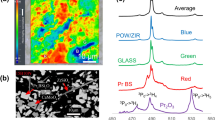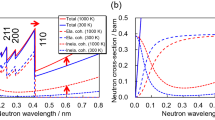Abstract
The smuggling of special nuclear materials (SNMs) across national borders is becoming a serious threat to nuclear nonproliferation. This paper presents a feasibility study on the rapid interrogation of concealed SNMs by combining scattering and transmission nuclear resonance fluorescence (sNRF and tNRF) spectroscopy. In sNRF spectroscopy, SNMs such as \(^{235, 238}\)U are excited by a wide-band photon beam of appropriate energy and exhibit unique NRF signatures. Monte Carlo simulations show that one-dimensional scans can realize isotopic identification of concealed \(^{235, 238}\)U when the detector array used for interrogation has sufficiently high energy resolution. The simulated isotopic ratio \(^{235}\)U/\(^{238}\)U is in good agreement with the theoretical value when the SNMs are enclosed in relatively thin iron. This interrogation is followed by tNRF spectroscopy using a narrow-band photon beam with the goal of obtaining tomographic images of the concealed SNMs. The reconstructed image clearly reveals the position of the isotope \(^{235}\)U inside an iron rod. It is shown that the interrogation time of sNRF and tNRF spectroscopy is one order of magnitude lower than that when only tNRF spectroscopy is used and results in a missed-detection rate of 10\(^{-3}\). The proposed method can also be applied for isotopic imaging of other SNMs such as \(^{239, 240}\)Pu and \(^{237}\)Np.








Similar content being viewed by others
References
IAEA, Incidents and Trafficking Database (ITDB) Incidents of nuclear and other radioactive material out of regulatory control, in Fact Sheet (International Atomic Energy Agency Vienna, Austria, 2020), p. 2020
C.D. Ferguson, W.C. Potter, A. Sands, The Four Faces of Nuclear Terrorism (Routledge, London, 2005)
R.T. Kouzes, E.R. Siciliano, J.H. Ely et al., Passive neutron detection for interdiction of nuclear material at borders. Nucl. Instrum. Methods A 584, 383–400 (2008). https://doi.org/10.1016/j.nima.2007.10.026
D. Cester, G. Nebbia, L. Stevanato et al., Special nuclear material detection with a mobile multi-detector system. Nucl. Instrum. Methods A 663, 55–63 (2012). https://doi.org/10.1016/j.nima.2011.10.011
C. Thomay, J. Velthuis, P. Baesso et al., A binned clustering algorithm to detect high-Z material using cosmic muons. J. Instrum. 8, P10013 (2013). https://doi.org/10.1088/1748-0221/8/10/P10013
E. Guardincerri, J. Bacon, K. Borozdin et al., Detecting special nuclear material using muon-induced neutron emission. Nucl. Instrum. Methods A 789, 109–113 (2015). https://doi.org/10.1016/j.nima.2015.03.070
P. Baesso, D. Cussans, J. Davies et al., High resolution muon tracking with resistive plate chambers. J. Instrum. 7, P11018 (2012). https://doi.org/10.1088/1748-0221/7/11/P11018
X.Y. Pan, Y.F. Zheng, Z. Zeng et al., Experimental validation of material discrimination ability of muon scattering tomography at the TUMUTY facility. Nucl. Sci. Tech. 30, 120 (2019). https://doi.org/10.1007/s41365-019-0649-4
D. Slaughter, M. Accatino, A. Bernstein et al., Detection of special nuclear material in cargo containers using neutron interrogation. Technical Report, Lawrence Livermore National Lab., CA (US) (2003). https://doi.org/10.2172/15005260
E.B. Norman, S.G. Prussin, R.M. Larimer et al., Signatures of special nuclear material: High-energy gamma rays following fission. Nucl. Instrum. Methods A 21 (LBNL-52806). https://www.osti.gov/biblio/837730
M. Huang, J.Y. Zhu, J. Wu, Study of spatial resolution of the associated alpha particle imaging-time-of-flight method. Nucl. Sci. Tech. 30, 64 (2019). https://doi.org/10.1007/s41365-019-0580-8
M.G. Paff, M. Monterial, P. Marleau et al., Gamma/neutron time-correlation for special nuclear material detection-active stimulation of highly enriched uranium. Ann. Nucl. Energy 72, 358–366 (2014). https://doi.org/10.1016/j.anucene.2014.06.004
M. Huang, J.Y. Zhu, J. Wu et al., Element analysis method of concealed explosive based on TNA. Nucl. Sci. Tech. 30, 6 (2019). https://doi.org/10.1007/s41365-018-0527-5
J. Mueller, M. Ahmed, H. Weller, A novel method to assay special nuclear materials by measuring prompt neutrons from polarized photofission. Nucl. Instrum. Methods A 754, 57–62 (2014). https://doi.org/10.1016/j.nima.2014.03.042
J. Zier, D. Mosher, R. Allen et al., High-power, photofission-inducing bremsstrahlung source for intense pulsed active detection of fissile material. Phys. Rev. Spec. Top. 17, 060401 (2014). https://doi.org/10.1103/PhysRevSTAB.17.060401
B.S. Henderson, H.Y. Lee, T.D. MacDonald et al., Experimental demonstration of multiple monoenergetic gamma radiography for effective atomic number identification in cargo inspection. J. Appl. Phys. 123, 164901 (2018). https://doi.org/10.1063/1.5025805
H.Y. Lan, T. Song, X.D. Huang et al., Nuclear resonance fluorescence drug inspection. Sci. Rep. 11, 1–9 (2021). https://doi.org/10.1038/s41598-020-80079-6
O. Beck, T. Ruf, Y. Finkelstein et al., Nondestructive determination of the \(^{13}\)C content in isotopic diamond by nuclear resonance fluorescence. J. Appl. Phys. 83, 5484–5488 (1998). https://doi.org/10.1063/1.367378
R. Hajima, N. Kikuzawa, N. Nishimori et al., Detection of radioactive isotopes by using laser Compton scattered \(\gamma \)-ray beams. Nucl. Instrum. Methods A 608, S57–S61 (2009). https://doi.org/10.1016/j.nima.2009.05.063
D. Habs, U. Köster, Production of medical radioisotopes with high specific activity in photonuclear reactions with \(\gamma \)-beams of high intensity and large brilliance. Appl. Phys. B 103, 501–519 (2011). https://doi.org/10.1007/s00340-010-4278-1
Y. Yu, B.F. Shen, Ultrafast measurements of ion temperature in high-energy-density plasmas by nuclear resonance fluorescence. Phys. Plasmas 26, 062708 (2019). https://doi.org/10.1063/1.5097641
T. Hayakawa, H. Ohgaki, T. Shizuma et al., Nondestructive detection of hidden chemical compounds with laser Compton-scattering gamma rays. Rev. Sci. Instrum. (2009). https://doi.org/10.1063/1.3125022
H. Toyokawa, T. Hayakawa, T. Shizuma et al., Nondestructive inspection of explosive materials using linearly polarized two-colored photon beam. Nucl. Instrum. Methods A 652, 21–24 (2011). https://doi.org/10.1016/j.nima.2011.01.158
R.S. Kemp, A. Danagoulian, R.R. Macdonald et al., Physical cryptographic verification of nuclear warheads. Proc. Natl. Acad. Sci. 113, 8618–8623 (2016). https://doi.org/10.1073/pnas.1603916113
J.R. Vavrek, B.S. Henderson, A. Danagoulian, Experimental demonstration of an isotope-sensitive warhead verification technique using nuclear resonance fluorescence. Proc. Natl. Acad. Sci. 115(17), 4363–4368 (2018). https://doi.org/10.1073/pnas.1721278115
H. Utsunomiya, T. Renstrøm, G. Tveten et al., \(\gamma \)-ray strength function for thallium isotopes relevant to the \(^{205}\)Pb-\(^{205}\)Tl chronometry. Phys. Rev. C 99, 024609 (2019). https://doi.org/10.1103/PhysRevC.99.024609
C. Ur, A. Zilges, N. Pietralla et al., Nuclear resonance fluorescence experiments at ELI-NP. Rom. Rep. Phys. 68, S483–S538 (2016)
H.Y. Lan, Y. Xu, W. Luo et al., Determination of the photodisintegration reaction rates involving charged particles: systematic calculations and proposed measurements based on the facility for Extreme Light Infrastructure-Nuclear Physics. Phys. Rev. C 98, 054601 (2018). https://doi.org/10.1103/PhysRevC.98.054601
Z.C. Zhu, W. Luo, Z.C. Li et al., Photo-transmutation of long-lived nuclear waste \(^{135}\)Cs by intense Compton \(\gamma \)-ray source. Ann. Nucl. Energy 89, 109–114 (2016). https://doi.org/10.1016/j.anucene.2015.11.017
E. Irani, H. Omidvar, R. Sadighi-Bonabi, Gamma rays transmutation of Palladium by bremsstrahlung and laser inverse Compton scattering. Energy Convers. Manag. 77, 558–563 (2014). https://doi.org/10.1016/j.enconman.2013.09.029
W. Luo, M. Bobeica, I. Gheorghe et al., Estimates for production of radioisotopes of medical interest at extreme light infrastructure-nuclear physics facility. Appl. Phys. B 122, 8 (2016). https://doi.org/10.1007/s00340-015-6292-9
W. Luo, D.L. Balabanski, D. Filipescu, A data-based photonuclear simulation algorithm for determining specific activity of medical radioisotopes. Nucl. Sci. Tech. 27, 113 (2016). https://doi.org/10.1007/s41365-016-0111-9
W. Luo, Production of medical radioisotope \(^{64}\)Cu by photoneutron reaction using ELI-NP \(\gamma \)-ray beam. Nucl. Sci. Tech. 27, 96 (2016). https://doi.org/10.1007/s41365-016-0094-6
O. Artun, Investigation of production of medical \(^{82}\)Sr and \(^{68}\)Ge for \(^{82}\)Sr/\(^{82}\)Rb and \(^{68}\)Ge/\(^{68}\)Ga generators via proton accelerator. Nucl. Sci. Tech. 29, 137 (2018). https://doi.org/10.1007/s41365-018-0474-1
I. Daito, H. Ohgaki, G. Suliman et al., Simulation study on computer tomography imaging of nuclear distribution by quasi monoenergetic gamma rays with nuclear resonance fluorescence: case study for ELI-NP application. Energy Procedia 89, 389–394 (2016). https://doi.org/10.1016/j.egypro.2016.05.051
G. Suliman, V. Iancu, C. Ur et al., Gamma-beam industrial applications at ELI-NP. Rom. Rep. Phys. 68, S799–S845 (2016)
H. Zen, H. Ohgaki, Y. Taira et al., Demonstration of tomographic imaging of isotope distribution by nuclear resonance fluorescence. AIP Adv. 9, 035101 (2019). https://doi.org/10.1063/1.5064866
K. Ali, H. Ohgaki, H. Zen et al., Selective isotope CT imaging based on nuclear resonance fluorescence transmission method. IEEE Trans. Nucl. Sci. 67, 1976–1984 (2020). https://doi.org/10.1109/TNS.2020.3004565
F.R. Metzger, Resonance fluorescence in nuclei. Prog. Nucl. Phys. 7, 54 (1959)
T. Ogawa, S. Hashimoto, T. Sato, Development of general nuclear resonance fluorescence model. J. Nucl. Sci. Technol. 53, 1766–1773 (2016). https://doi.org/10.1080/00223131.2016.1159148
A. Zilges, P. Von Brentano, R.-D. Herzberg et al., Strong dipole excitations around 1.8 MeV in \(^{238}\)U. Phys. Rev. C 52, R468 (1995). https://doi.org/10.1103/PhysRevC.52.R468
E. Kwan, G. Rusev, A. Adekola et al., Discrete deexcitations in \(^{235}\)U below 3 MeV from nuclear resonance fluorescence. Phys. Rev. C 83, 041601 (2011). https://doi.org/10.1103/PhysRevC.83.041601
L.W. Fagg, S.S. Hanna, Polarization measurements on nuclear gamma rays. Rev. Mod. Phys. 31, 711 (1959). https://doi.org/10.1103/RevModPhys.31.711
K. Siegbahn, Alpha-, Beta- and Gamma-Ray Spectroscopy, vol. 2 (North-Holland, Amsterdam, 1965)
J. Pruet, D.P. Mcnabb, C.A. Hagmann et al., Detecting clandestine material with nuclear resonance fluorescence. J. Appl. Phys. 99, 123102 (2006). https://doi.org/10.1063/1.2202005
S. Agostinelli, J. Allison, K.A. Amako et al., GEANT4: a simulation toolkit. Nucl. Instrum. Methods A 506, 250–303 (2003). https://doi.org/10.1016/S0168-9002(03)01368-8
W. Luo, H.Y. Lan, Y. Xu et al., Implementation of the n-body Monte-Carlo event generator into the Geant4 toolkit for photonuclear studies. Nucl. Instrum. Methods A 849, 49–54 (2017). https://doi.org/10.1016/j.nima.2017.01.010
H.R. Weller, M. Ahmed, Y. Wu, Nuclear physics research at the high intensity gamma-ray source (HI\(\gamma \)S). Nucl. Phys. News 25, 19–24 (2015). https://doi.org/10.1080/10619127.2015.1035932
K. Tanaka, K. Spohr, D.L. Balabanski et al., Current status and highlights of the ELI-NP research program. Matter Radiat. Extrem. 5, 024402 (2020). https://doi.org/10.1063/1.5093535
N. Kikuzawa, R. Hajima, N. Nishimori et al., Nondestructive detection of heavily shielded materials by using nuclear resonance fluorescence with a laser-Compton scattering \(\gamma \)-ray source. Appl. Phys. Express 2, 036502 (2009). https://doi.org/10.1143/APEX.2.036502
H. Toyokawa, H. Ohgaki, T. Hayakawa et al., Two-dimensional isotope imaging of radiation shielded materials using nuclear resonance fluorescence. Jpn. J. Appl. Phys. 50, 100209 (2011). https://doi.org/10.1143/JJAP.50.100209
W. Luo, W. Xu, Q.Y. Pan et al., A 4D Monte Carlo laser-Compton scattering simulation code for the characterization of the future energy-tunable SLEGS. Nucl. Instrum. Methods A 660, 108–115 (2011). https://doi.org/10.1016/j.nima.2011.09.035
A.H. Andersen, A.C. Kak, Simultaneous algebraic reconstruction technique (SART): a superior implementation of the art algorithm. Ultrason Imaging 6, 81–94 (1984). https://doi.org/10.1016/0161-7346(84)90008-7
Author information
Authors and Affiliations
Corresponding author
Additional information
This work was supported by the National Natural Science Foundation of China (No. 11675075), Youth Talent Project of Hunan Province, China (No. 2018RS3096), Independent Research Project of Key Laboratory of Plasma Physics, CAEP (No. JCKYS2020212006) and Innovation and Entrepreneurship Training Program for College Students of University of South China (No. X2019083)
Rights and permissions
About this article
Cite this article
Lan, HY., Song, T., Zhang, JL. et al. Rapid interrogation of special nuclear materials by combining scattering and transmission nuclear resonance fluorescence spectroscopy. NUCL SCI TECH 32, 84 (2021). https://doi.org/10.1007/s41365-021-00914-x
Received:
Revised:
Accepted:
Published:
DOI: https://doi.org/10.1007/s41365-021-00914-x




